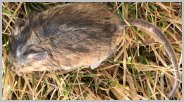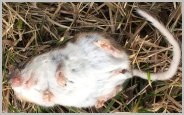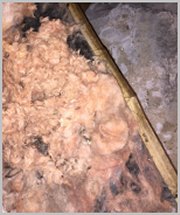^Top
of Page^
|
Deer
Mice
This
mouse, commonly called the "Deer Mouse" or
"White-Footed
Mouse" in
Wisconsin, is sometimes called long-tail field mouse
or prairie
white-footed mouse. Other names include Baird's
deer
mouse, Baird's
white-footed mouse, Michigan deer mouse, Michigan prairie mouse,
Michigan white-footed mouse, Michigan wood mouse, and prairie
mouse.
Measuring
from notch to tip an adult deer mouse is usually less than 160 mm. in
total length. The shorter tail is only 40% of the total body length
(usually less than 65 mm.).
Little
information is known of reproduction in Wisconsin. The mice commence
breeding in March or April, and continue breeding into September.
Litters are 3-5 pups.
^Top
of Page^
|



^ Mice
nesting in attic insulation
|
House
Mouse
House
mice infestations can happen quickly! House
mice
are only pregnant for about 20 days, and after giving birth can
become pregnant again within just 12 hours! If a female doesn't get
pregnant again within the first 24 hours, she will be able to get
pregnant again every 4-5 days onwards. In a single litter a house mouse
can have anywhere from 4-12+ pups.
The
house mouse measures 6.3 to 7.9 inches and the tail measures 3.0 to 3.7
inches. The house mouse can be found in and around houses, stores,
warehouses, granaries, barns and other buildings; frequently in fields
and meadows during summer months; and rarely in marshes.
^Top
of Page^
Norway
Rat
The
Norway
rat (aka: the brown rat
or sewer
rat) is a destructive pest found in urban
and suburban neighborhoods.
 These rodents eat and contaminate
food,
damage buildings and other property by their gnawing and burrowing, and
may spread diseases that affect people and pets.
These rodents eat and contaminate
food,
damage buildings and other property by their gnawing and burrowing, and
may spread diseases that affect people and pets.
These
rats are
husky, brownish rodents that weigh about 11 ounces. About 13" long,
including the 6 to 8½" tail. Their fur is course and mostly brown with
scattered black on the upper surfaces.
Norway
rats will
climb to find food or shelter, and they can gain entrance to a building
through any opening larger than ½" across. They have litters of 6-12
young, born 21-23 days after mating, and they reach maturity in about 3
months. Breeding is most active in spring and fall, and the female has
4-6 litters per year.
^Top
of Page^
Roof
Rat
As
the seasons change from summer to fall, roof rats
are
on the move--to
indoors in search of their preferred nesting places, in the warmer
upper level of homes and garages.
Roof
rats like to gnaw the wires and hoses under car hoods, boats and
motorhomes; gnawing on anything to keep their front teeth from growing
too long, even concrete. They eat almost anything, but they prefer
stored foods, fruit, vegetables, nuts and pet food (especially cat
food).
 An infestation
of roof rats in one home means as
much as 6 out of 10
nearby homes will be infested, thus, the entire neighborhood will need
to be vigilant, work together to eradicate
these
pesky, plague-carrying
vermin (transmit disease by droppings and urine, bites, and the fleas
and mites in their fur).
An infestation
of roof rats in one home means as
much as 6 out of 10
nearby homes will be infested, thus, the entire neighborhood will need
to be vigilant, work together to eradicate
these
pesky, plague-carrying
vermin (transmit disease by droppings and urine, bites, and the fleas
and mites in their fur).
The
roof rat measures anywhere from 13-18 inches, including its tail,
weights 5-9 ounces, and have large, almost naked, ears. They prefer to
live four feet or more off the ground, and can squeeze through a hole
the size of a quarter.
Females
have 4-6 litters per year, with 6-8 young per litter. The young mature
in 2-5 months, and are adults for 9-12 months. Pregnancy takes 3 weeks.
^Top
of Page^
